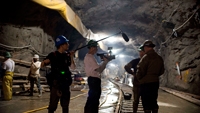Filmmaker goes deep with AG-HVX200 to uncover story of Water Tunnel No. 3

Manhattan-based filmmaker Eddie Rosenstein, a founder of Eyepop Productions, is the creator, director and co-director of photography of the upcoming two-hour History Channel special “The Greatest Tunnel Ever Built.”
Shot with Panasonic’s solid-state AG-HVX200 P2 HD camcorders, “The Greatest Tunnel Ever Built” profiles New York City’s legendary urban tunnel workers, known as “sandhogs.”
Currently, the sandhogs are building the city’s third water tunnel, scheduled to go online in 2013, to help alleviate New York City’s serious long-term water problem. Initiated 40 years ago, Water Tunnel No. 3 represents the largest public works project in the Western Hemisphere and will ultimately pump 1.2 billion gallons of water a day into Manhattan, Queens, Brooklyn and the Bronx.
Before shooting ever began, Rosenstein decided to actually become a sandhog, becoming a member of the Laborers’ International Union and earning an explosives license. Laboring for months in Water Tunnel No. 3 at the Croton Filtration Plant and within the tunnel’s 600ft shafts, Rosenstein earned the trust of his fellow sandhogs and was invited to bring a camera to the work site to shoot the subterranean work.
After initially shooting with the Panasonic DVX100A MiniDV camera, Rosenstein and his small crew of filmmakers began using the Panasonic solid-state AG-HVX200 P2 HD camcorder to acquire HD footage.
Excited about the special, History commissioned the 11-part “Sandhogs” series, and Los Angeles-based Pilgrim Films signed on as co-producers. Production was increased to meet the demand, with two full crews, each equipped with two HVX200s, working 12-hour shifts. The cameras were rented from Video Equipment Rentals of New York.
Both “The Greatest Tunnel Ever Built” and “Sandhogs” were shot at 720/24pN, with extensive off-speed and time-lapse shooting. At the time of the special shoot last winter, Rosenstein worked with 8GB and 16GB P2 cards and would offload material underground using an AJ-PCS060G P2 Store. By the time of the series shoot, the crews were each equipped with multiple 32GB cards and footage was offloaded at the end of a day’s shoot.
Get the TV Tech Newsletter
The professional video industry's #1 source for news, trends and product and tech information. Sign up below.
Eyepop Productions edited the special in Final Cut Pro; the color correction was done in Final Cut Studio 2’s Color program by colorist Ben Flaherty at Edgeworx in New York City. Pilgrim Films handled the series edit, which was done on an Avid Unity system. The special and series were delivered to History on D5 HD.
For more information, visit www.eyepopproductions.com and www.panasonic.com/P2HD.
